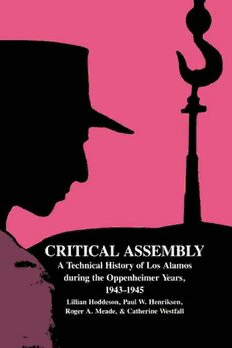
Critical Assembly : A Technical History of Los Alamos During the Oppenheimer Years, 1943-1945 PDF
528 Pages·39.386 MB·English
Most books are stored in the elastic cloud where traffic is expensive. For this reason, we have a limit on daily download.
Preview Critical Assembly : A Technical History of Los Alamos During the Oppenheimer Years, 1943-1945
Description:
This volume treats the technical research that led to the first atomic bombs. The authors explore how the «critical assembly» of scientists, engineers, and military personnel at Los Alamos collaborated during World War II, blending their traditions to create a new approach to large-scale research. The research was characterized by strong mission orientation, multidisciplinary teamwork, expansion of the scientists traditional methodology with engineering techniques, and a trial-and-error methodology responding to wartime deadlines.The book opens with an introduction laying out major themes After a synopsis of the prehistory of the bomb project, from the discovery of nuclear fission to the start of the Manhattan Engineer District, and an overview of the early materials program, the book examines the establishment of the Los Alamos Laboratory, the implosion and gun assembly programs, nuclear physics research, chemistry and metallurgy, explosives, uranium and plutonium development, confirmation of spontaneous fission in pile-produced plutonium, the thermonuclear bomb, critical assemblies, the Trinity test, and delivery of the combat weapons. Readers interested in the development of the atomic bomb will find many previously unrevealed details in this volume while those interested in the more general history of science will find this volume a crucial resource for understanding the underpinnings of contemporary science and technology.
See more
The list of books you might like
Most books are stored in the elastic cloud where traffic is expensive. For this reason, we have a limit on daily download.
